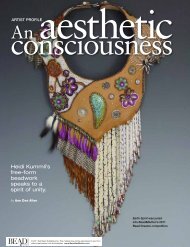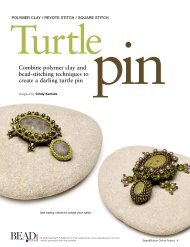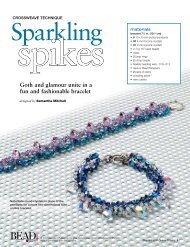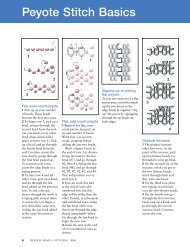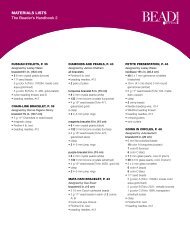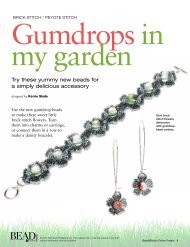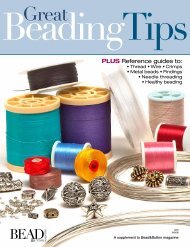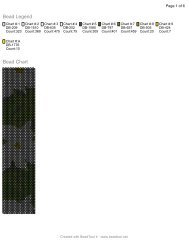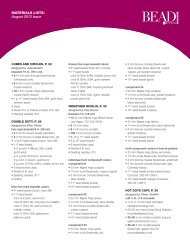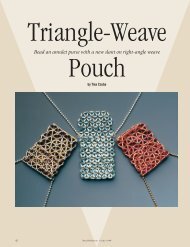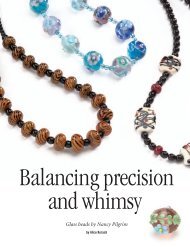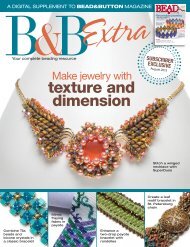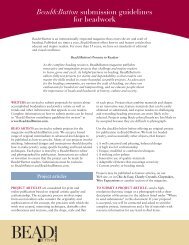Karen Paust - Bead and Button Magazine
Karen Paust - Bead and Button Magazine
Karen Paust - Bead and Button Magazine
Create successful ePaper yourself
Turn your PDF publications into a flip-book with our unique Google optimized e-Paper software.
“I love my mobiles. They are my<br />
favorite things,” says <strong>Paust</strong>. It’s no<br />
wonder <strong>Paust</strong> is partial to them.<br />
With creations so lifelike, they only<br />
need the animation of a breeze to<br />
complete the illusion.<br />
“As an artist, I don’t really categorize<br />
myself,” she says. “For me, it<br />
is important to explore all types of<br />
mediums <strong>and</strong> be open to evolving. I<br />
keep a journal to sketch <strong>and</strong> write<br />
down poems, dreams, <strong>and</strong> ideas,<br />
which can materialize into beaded<br />
pieces, paintings, sculptures, knitted<br />
sculptures, or wearable pieces.”<br />
>> In the neckpiece Autumnal<br />
Equinox, the elements are so<br />
lifelike that the sunflower<br />
dazzles even when viewed from<br />
the back. <strong>Paust</strong> doesn’t stint<br />
on the flower’s sepals any more<br />
than she would on its petals.<br />
Photo by T.E. Crowley<br />
Across the country <strong>and</strong> back<br />
Looking to exp<strong>and</strong> her horizons,<br />
<strong>Paust</strong> moved to Santa Barbara,<br />
California, in 1988. “I wanted an<br />
adventure,” she says. “But it was<br />
difficult being an artist in Southern<br />
California. I had three jobs to pay<br />
the rent <strong>and</strong> very little time to work<br />
on my beading.”<br />
Then, a wildfire swept through<br />
her neighborhood, <strong>and</strong> <strong>Paust</strong> lost<br />
everything. All her beadwork went<br />
up in smoke, except five pieces she<br />
had sent to be photographed for<br />
publication.<br />
Word got out through Alice<br />
Scherer’s beading newsletter about<br />
<strong>Paust</strong>’s ordeal. No sooner had the<br />
item appeared than <strong>Paust</strong> began<br />
receiving packages of beads. “It was<br />
like Christmas,” she recalls. “For<br />
months afterwards I received small<br />
parcels <strong>and</strong> encouraging notes.”<br />
Despite the support, it was time<br />
to return to Pennsylvania. With<br />
more time to focus on her beadwork,<br />
she received more recognition.<br />
Her carefully wrought pieces<br />
attracted collectors, <strong>and</strong> the Mobilia<br />
Gallery in Cambridge, Massachusetts,<br />
<strong>and</strong> Julie Artisans’ Gallery in<br />
New York began to represent her.<br />
In her studio<br />
We’ve finished our tea, <strong>and</strong> <strong>Paust</strong><br />
invites me down to her studio. A tall<br />
cabinet holds a splendid assortment<br />
of beads, ordered by hue. There are<br />
pots of crochet <strong>and</strong> knitting needles,<br />
jars of buttons, even a container of<br />
cast-off beaded insects, leaves, <strong>and</strong><br />
Of her Spring<br />
in the Woods<br />
neckpiece, <strong>Paust</strong><br />
says, “On a springtime hike, I<br />
came across a Luna moth that had<br />
just emerged from its cocoon <strong>and</strong><br />
was drying its wings. I thought it<br />
would be challenging to bead a<br />
neckpiece with the moth <strong>and</strong> the<br />
early-spring flowers that were blooming.”<br />
flowers that didn’t make the cut. She<br />
dumps them out <strong>and</strong> sorts through<br />
them, pointing out what failing<br />
made her ab<strong>and</strong>on each one.<br />
<strong>Paust</strong> then demonstrates her<br />
favorite way to bead: st<strong>and</strong>ing up<br />
with her beadwork perched on a<br />
chin-high windowsill.<br />
“It’s the most comfortable way<br />
for me to work because the beads<br />
are right at eye level <strong>and</strong> the light is<br />
good,” she explains, laughing a bit<br />
because of how unusual it looks.<br />
A few of her bead paintings hang<br />
on the wall, <strong>and</strong> I stop to admire one.<br />
Photo by T.E. Crowley<br />
>> In Trying to Root, a surreal figure – half woman, half<br />
carrot – is planted among common plants – sunflower, thistle,<br />
thorn apple, morning glory, wisteria, <strong>and</strong> beet. <strong>Paust</strong> uses a<br />
pointillist comm<strong>and</strong> of the color spectrum in this portrayal,<br />
dappling the carrot woman’s skin with purple, red, <strong>and</strong> green.<br />
“I love beads because they are the<br />
perfect medium to illustrate the way<br />
the universe is made of tiny bits of<br />
energy,” she says. I’d venture that<br />
<strong>Paust</strong>’s studio buzzes with such<br />
energy. After a joyful farewell, I<br />
leave <strong>Paust</strong> to return to the moth or<br />
wherever her boundless creative<br />
energy leads. w<br />
Contact <strong>Karen</strong> <strong>Paust</strong> in care of<br />
<strong>Bead</strong>&<strong>Button</strong>, or visit her website,<br />
www.karenpaust.com, scheduled to<br />
debut in early September. Contact<br />
Pam O’Connor at pampal@msn.com.<br />
Photo by T.E. Crowley<br />
bead<strong>and</strong>button.com | October 2006 117



